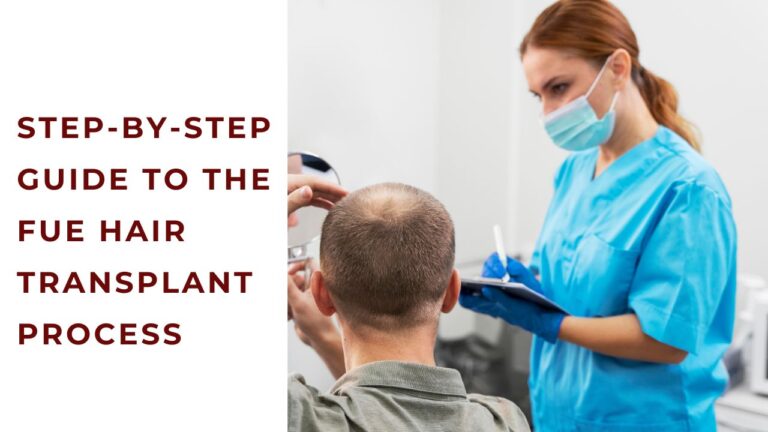Hair thinning and hair loss affect millions of individuals worldwide, affecting not only physical appearance but also confidence and emotional well-being. Thankfully, advances in hair restoration offer effective solutions, one of the most popular being the FUE hair transplant.
Short for Follicular Unit Extraction, this minimally invasive procedure has gained attention for its natural-looking results and relatively short recovery time. If you’re considering this option, understanding the process step by step can help you feel more secure and prepared. In this guide, we’ll walk through exactly what you can expect before, during, and after the FUE hair transplant procedure.
Step 1: Initial Consultation and Evaluation
Every successful FUE hair transplant begins with a personalised consultation. During this session, a specialist evaluates your hair loss pattern, medical history, and hair density in the donor area. They may also perform scalp analysis using magnification tools or imaging technology.
The goal here is to determine if you’re a good candidate for FUE. Factors like age, hair texture, and long-term hair loss expectations all play a role in developing the right treatment plan.
Step 2: Pre-Procedure Preparation
Once you’re approved for the procedure, you’ll receive a set of pre-op instructions. These may include avoiding alcohol, smoking, and blood-thinning medications for a few days before surgery. You might also be advised to wash your hair with a specific shampoo the night before.
On the day of the transplant, the expert medical team will trim the donor area to allow better visibility and access to the hair follicles. Don’t worry—the rest of your hair remains untouched unless otherwise planned.
Step 3: Local Anaesthesia and Donor Hair Extraction
To ensure comfort, local anaesthesia is administered to numb the donor area. The extraction phase involves using a specialised micro-punch tool (usually between 0.7mm and 1mm in diameter) to harvest hair follicles one by one.
This part of the FUE hair transplant process can take several hours, depending on the number of grafts required. Since the method is minimally invasive, most patients report minimal discomfort—many even read or listen to music during the session.
Step 4: Graft Preparation and Quality Control
After extraction, each follicular unit is carefully examined and sorted under a microscope. Technicians clean and preserve the grafts in a temperature-controlled environment to maintain their viability.
The attention to detail here is critical. The way follicles are handled directly impacts the quality of your results. Only healthy, undamaged grafts make it to the next step.
Step 5: Recipient Site Creation
Next, the surgeon uses fine instruments to create tiny incisions in the recipient area, where the follicles will be implanted. These sites are strategically planned to match the natural direction, angle, and density of your existing hair.
Creating these sites requires both technical skill and artistic vision. The success of an FUE hair transplant depends heavily on how well this step is performed.
Step 6: Follicle Implantation
Once the recipient sites are ready, the grafts are inserted one at a time. Precision is key—each follicle must be placed in the correct orientation for natural-looking results. This is a meticulous and time-consuming part of the procedure, but crucial to its success.
Implantation often takes several hours. You may be encouraged to take short breaks, eat, or stretch depending on the session length.
Step 7: Post-Procedure Care and Recovery
After the transplant, you’ll be given aftercare instructions. These typically include guidelines for sleeping, washing your hair, and avoiding physical activities for the first few days. Mild swelling or redness is normal and usually subsides within a week.
Patients can typically return to their work within 3–5 days. Full hair growth, however, takes time. Most people start to see visible changes within 3–4 months, with full results around 9–12 months post-surgery.
Why Choose FUE Over Other Methods?
The FUE hair transplant has several advantages over traditional techniques. There’s no visible scarring, a shorter recovery period, and less postoperative discomfort. It’s also suitable for a wide range of hair types and styles, including those who prefer short haircuts.
Because it doesn’t require stitches, there’s a reduced risk of infection, and patients often feel more confident about the natural look of their results.
Clinics with experienced teams and advanced technology—like Beverly Hills Hair Restoration—play a big role in the success and comfort of this procedure. Their emphasis on precision and patient care helps ensure lasting, realistic outcomes.
Conclusion: Is FUE Hair Transplant Right for You?
If you’re struggling with hair loss or bald patches, a FUE hair transplant may offer a long-term, natural-looking solution. The process is highly customizable, and with the right clinic and care, results can be life-changing.
Understanding the procedure step by step makes it easier to set expectations, minimise anxiety, and make informed choices. From consultation to final regrowth, FUE stands out as a modern, effective way to restore your hair and your confidence.
While results take time, the payoff is often well worth the wait. If you’re thinking about taking that first step, start with a consultation to explore if this technique is the right fit for your needs.
